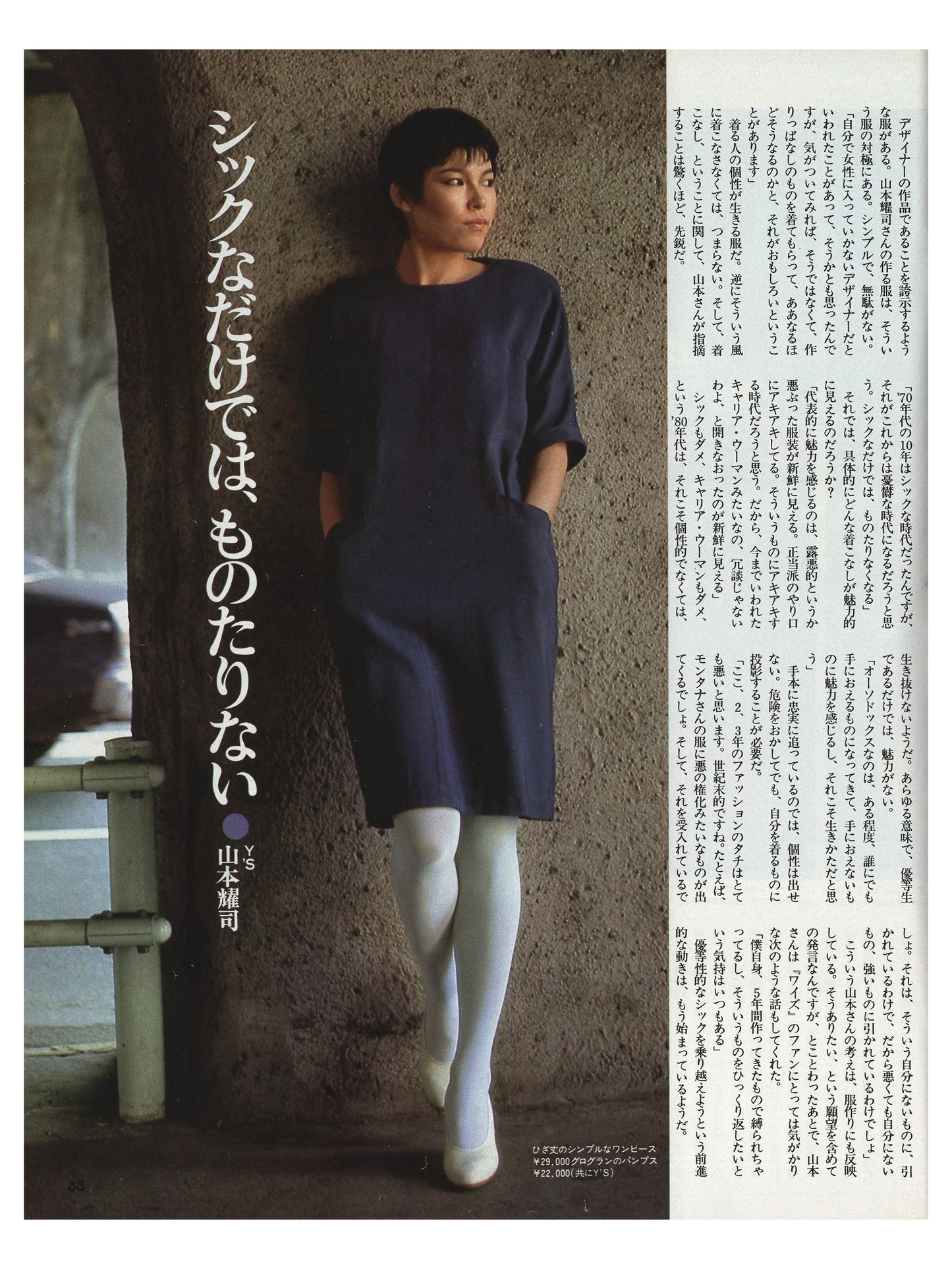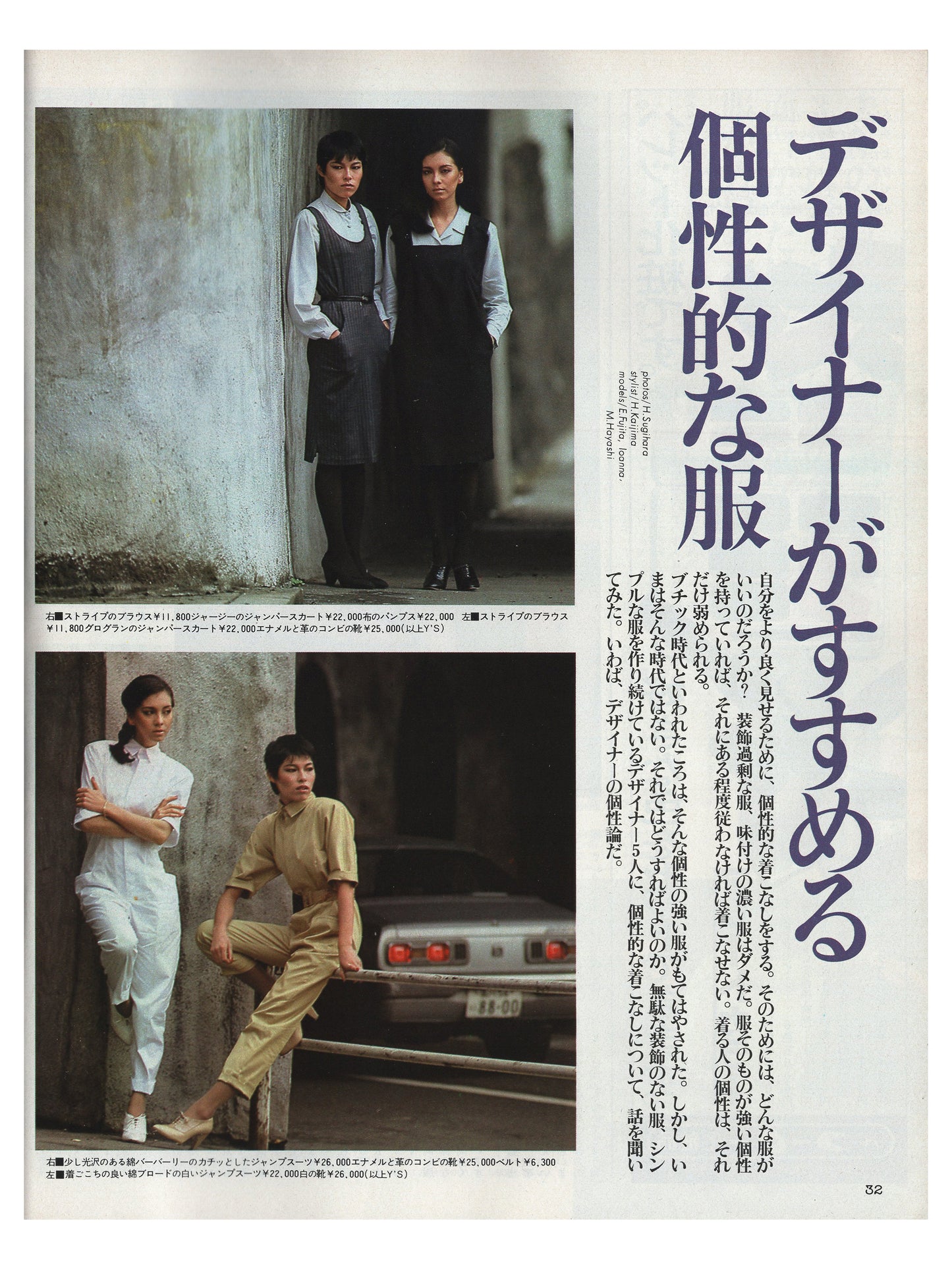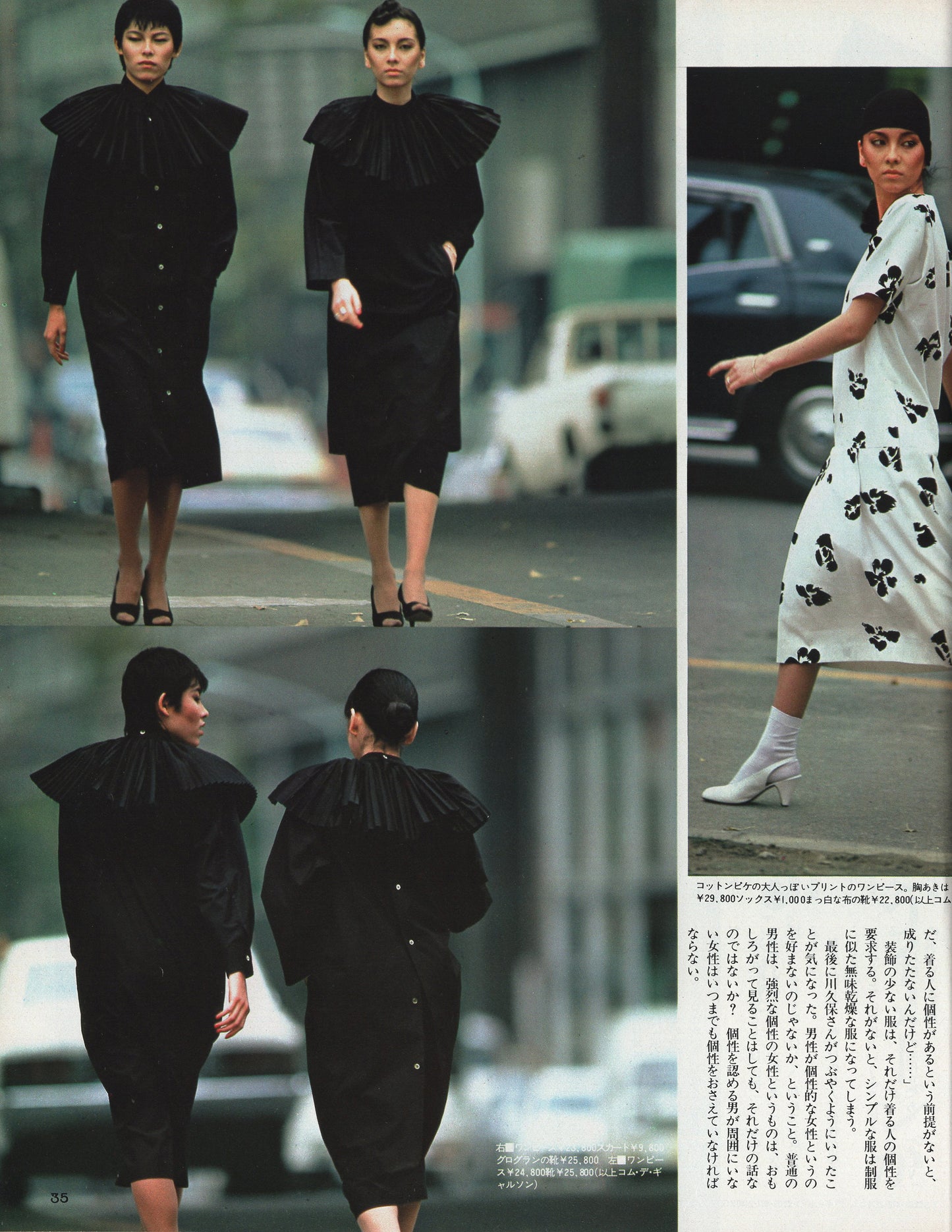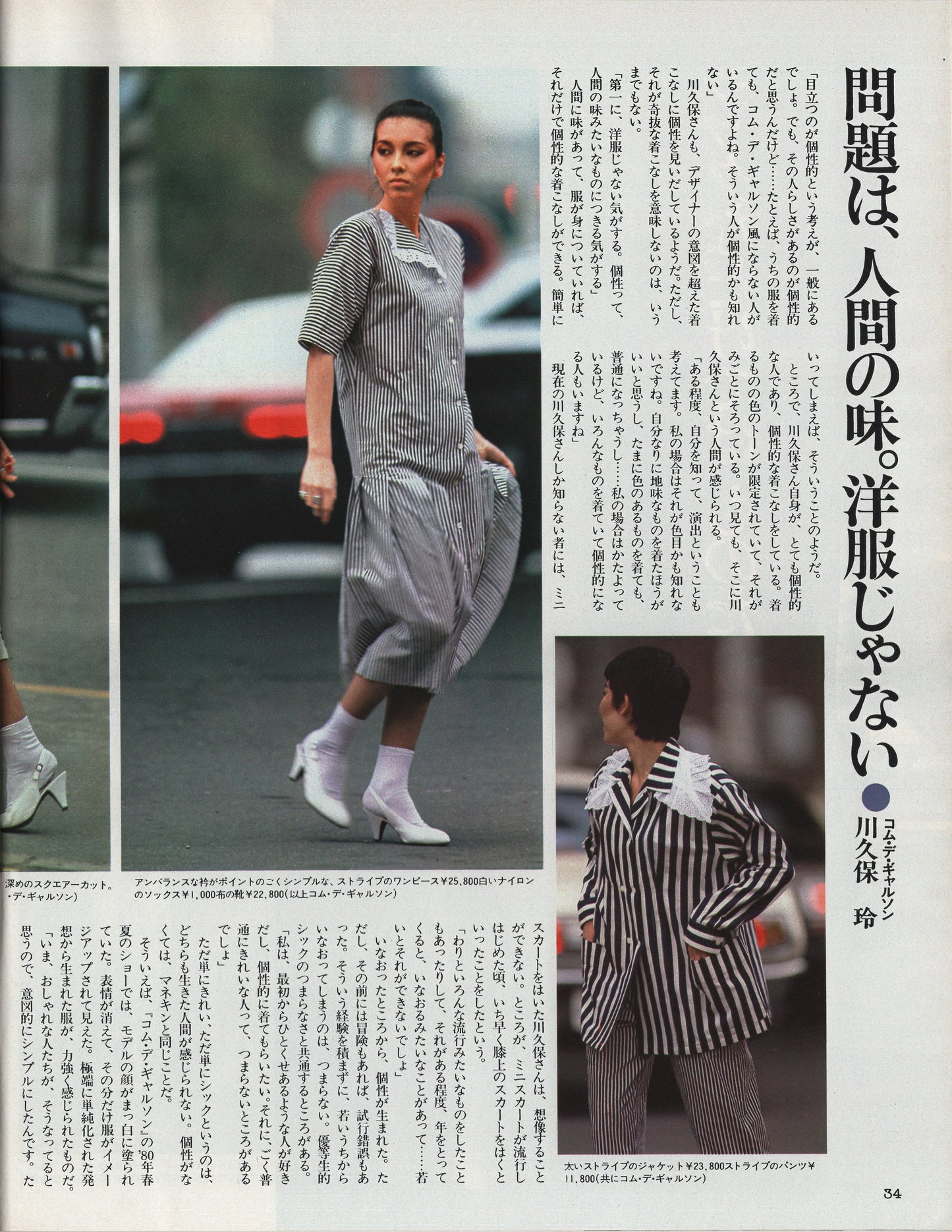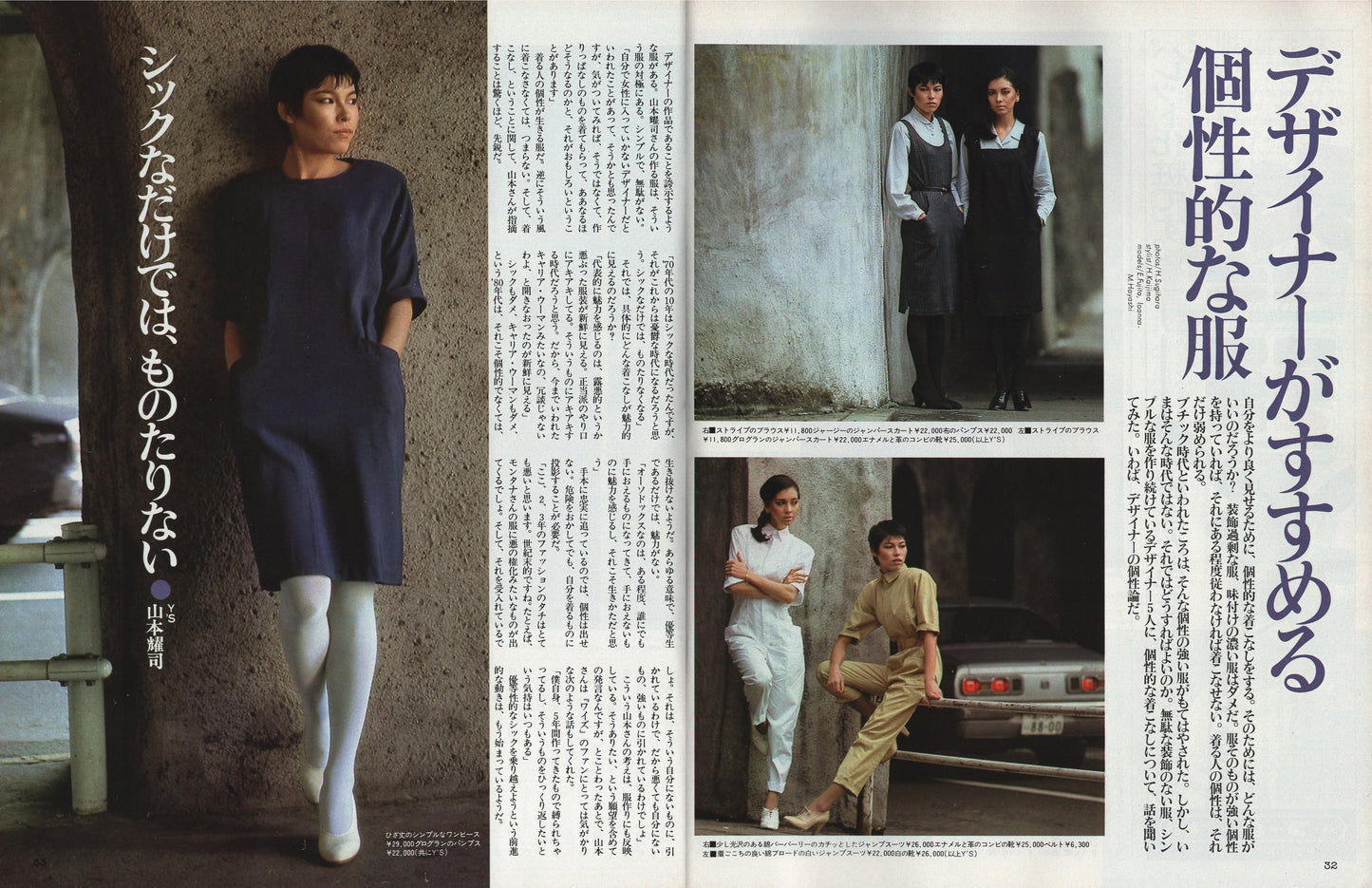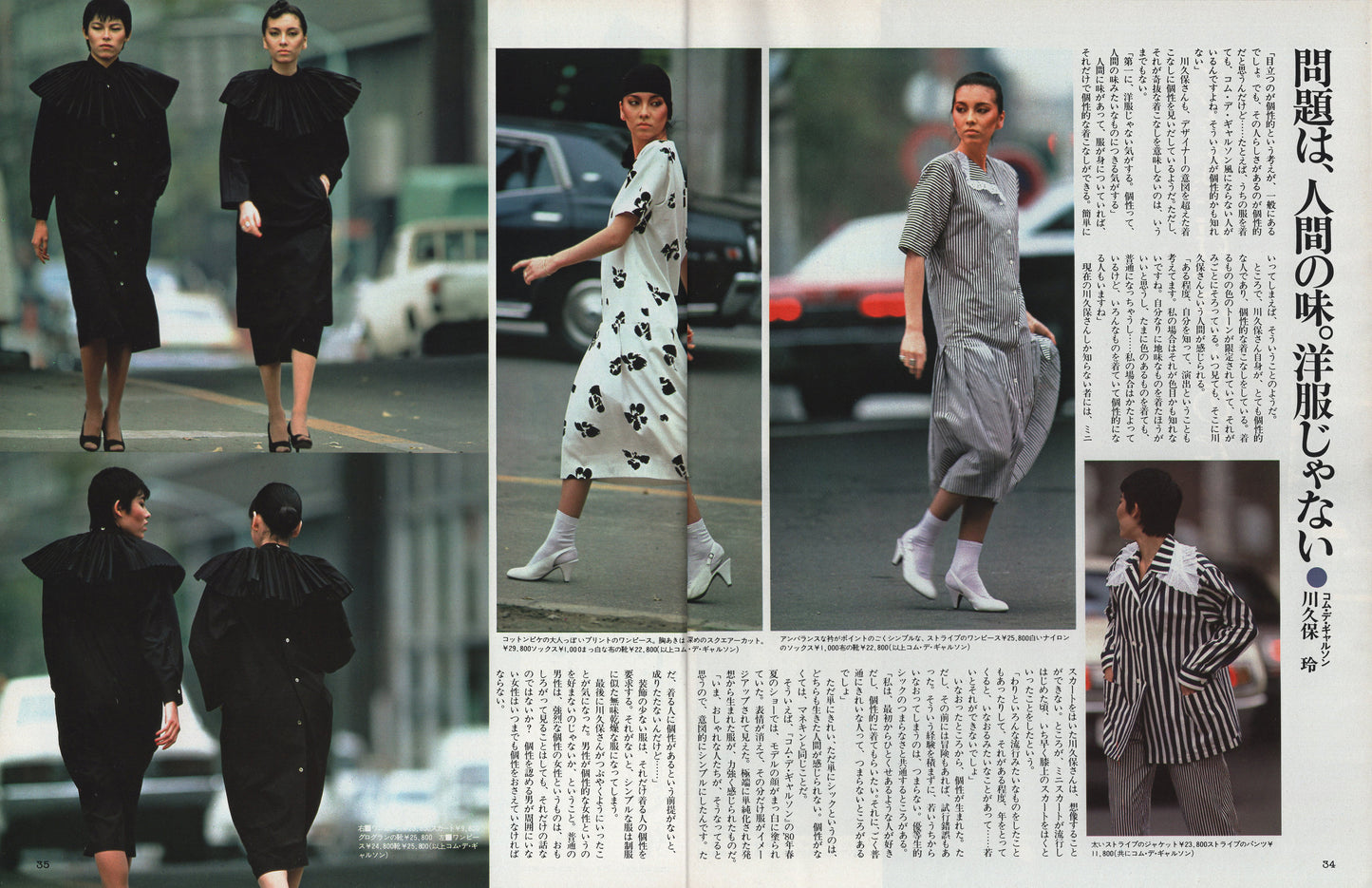1
/
of
6
an an ∙ jan 1980
an an ∙ jan 1980
y's
Regular price
1 CAD
Regular price
Sale price
1 CAD
Unit price
/
per
description
y's and cdg looks featured in an an magazine about a year before their international paris debuts. both veterans in the industry by this point, it's evident that their stylistic and spiritual foundations were solidified and ready to build upon for decades to come.
notes
photo ∙ h. sugihara
stylist ∙ h. kaijima
models ∙ e. fujita, ioanna, m. hayashi
published by heibon shuppan co. ltd.
softcover ∙ 23.5 x 29.5 cm ∙ 4 pp
Unique Clothes Recommended by Designers
To present oneself better, one dresses in an individualistic way. So then, what kind of clothes are good for that? Clothes that are excessively decorative or heavily styled are no good. If the clothes themselves have a strong individuality, one must, to a certain extent, conform to them in order to wear them well. As a result, the individuality of the person wearing them is weakened. During what was called the boutique era, such strongly individualistic clothes were in favor. But that is no longer the case today. Then, what should one do? We asked five designers, who continue to make simple clothing without unnecessary decoration, about how to dress in an individualistic way. It is, so to speak, a theory of individuality according to designers.
Being chic alone is not enough ● Yohji Yamamoto
There are clothes that flaunt the fact they are a designer’s creation. Yohji Yamamoto’s clothes are the complete opposite of that — simple and without waste. “I was once told that I’m a designer who doesn’t approach women directly through clothing, and I thought, ‘maybe that’s true.’ But upon reflection, I realized that’s not quite it. What I find interesting is when someone wears what I’ve made just as it is, and then I see — ah, so that’s what it becomes.” These are clothes that let the wearer’s individuality shine. Conversely, if they’re not worn that way, they become uninteresting. And when it comes to styling, what Yamamoto points out is, surprisingly, extremely sharp.
“What I find typically appealing is a kind of shameless, almost defiant way of dressing — it looks fresh. I’m completely fed up with the conventional, proper way of doing things. I think we’re living in an era where people are tired of that. So when someone throws off the old ‘career woman’ image and says, ‘You’ve got to be kidding,’ it looks refreshing.” Chic doesn’t work. The career woman look doesn’t work either. It seems that in the 1980s, unless you’re truly individualistic, you can’t survive. Being a model student in every sense just isn’t attractive anymore. “The orthodox has, to some extent, become something anyone can handle, and I feel drawn to the things that are out of reach — because that, I believe, is what living truly means.” If you just faithfully follow the model, you can’t express individuality. Even at the risk of danger, it’s necessary to project yourself onto what you wear.
“I think the nature of fashion in the past two or three years has been very bad. It’s quite fin-de-siècle (end of an era). For example, in Mr. Montana’s clothing, you can see something like the embodiment of evil emerging. And people are accepting that, aren’t they? That means he’s drawn to something he himself doesn’t have — so even if it’s something bad, he’s attracted to what he lacks, to something strong, right?" This kind of thinking by Mr. Yamamoto is also reflected in his clothing design. He also shared the following, which might be a concern for fans of Y’s. “I myself feel constrained by what I’ve created over the past five years, and I always have the desire to overturn those things.” It seems that a progressive movement to overcome the “model student” style of chic has already begun.
(Left)
Knee-length simple one piece dress ¥29,000 Grosgrain pumps ¥22,000 (both by Y’s)
(Top Right)
Left ∙ Striped blouse ¥11,800 Grosgrain jumper skirt ¥22,000 Fabric pumps ¥22,000
Right ∙ Striped blouse ¥11,800 Jersey jumper skirt ¥22,000 Enamel and leather combination shoes ¥25,000 (All items by Y's)
(Bottom Right)
Left ∙ Comfortable white jumpsuit made of cotton broadcloth ¥22,000 White shoes ¥26,000
Right ∙ Structured jumpsuit made of slightly glossy cotton Burberry ¥26,000 Enamel and leather combination shoes ¥25,000 Belt ¥6,300 (All items by Y's)
The issue is human taste. Not the clothes ● Rei Kawakubo (Comme des Garçons)
“There’s a common belief that standing out equals being individualistic. But I think being individualistic means having something that’s truly your own… For example, even when someone wears our clothes, there are people who don’t end up looking ‘Comme des Garçons-ish.’ Those people might be truly individualistic.” It seems that Kawakubo also finds individuality in the way people wear clothes beyond the designer’s intent.
Needless to say, that doesn’t mean dressing in an eccentric way. To put it simply, that seems to be the essence of it. By the way, Kawakubo herself is a very individualistic person, and her way of dressing is also highly distinctive. The tones of the colors she wears are limited, and they are beautifully coordinated. Whenever you see her, you can always feel the presence of Kawakubo as a person. “To some extent, I understand myself, and I also think about presentation. In my case, that might be in terms of color. I feel it’s better for me to wear subdued things, and even when I wear something colorful, it ends up looking ordinary… I may have a bias, but there are also people who become individualistic by wearing a variety of things.”
For those who only know the current Kawakubo, it’s hard to imagine her wearing a miniskirt. However, when miniskirts first started to become fashionable, she was one of the first to wear skirts above the knee. “I actually tried out a lot of trends and such, and as you get older, there’s a sort of settling into yourself… when you’re young, you can’t really do that, right?” From that settling, individuality was born. However, before reaching that point, there were also adventures and trials and errors. Settling into oneself without going through such experiences while still young is uninteresting. It shares something in common with the dullness of honor-student-like chic.
“I’ve always liked people who have something a little unusual about them, and I want them to dress with individuality. Also, people who are just ordinarily pretty can be a bit boring, don’t you think?” Just being pretty, just being chic — neither lets you feel a truly living person. Without individuality, you’re no different from a mannequin. Come to think of it, in the 1980 spring/summer show of Comme des Garçons, the models’ faces were painted completely white. Their expressions were erased, and because of that, the clothes themselves appeared more elevated in their image. The garments, born from an extremely simplified concept, felt powerful. “I think that’s where fashionable people are right now, so I intentionally made it simple,” she said.
However, it only works if the wearer has individuality… Clothes with minimal decoration demand the wearer’s personality. Without that, simple clothes become bland, like a uniform. At the end, Kawakubo muttered something that stuck with me: that men might not like women with strong individuality. Ordinary men might find such women interesting at first, but that’s about it. Women who don’t have men around them who accept their individuality must always suppress it.
(Left)
Left ∙ One-piece dress ¥24,800 Shoes ¥25,800
Right ∙ One-piece dress ¥23,800 Skirt ¥9,800 Grosgrain Shoes ¥25,800 (all by Comme des Garçons)
(Second from left)
A mature printed cotton pique one-piece dress with a deep square-cut neckline ¥29,800 Socks ¥1,000 Pure white fabric shoes ¥22,800 (all by Comme des Garçons)
(Second from right)
A very simple striped one-piece dress with an unbalanced collar as the key feature ¥25,800 White nylon socks ¥1,000 Fabric shoes ¥22,800 (all by Comme des Garçons)
(Right)
Wide-striped jacket ¥23,800 Striped pants ¥11,800 (both by Comme des Garçons)
